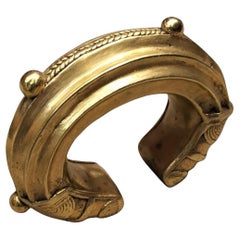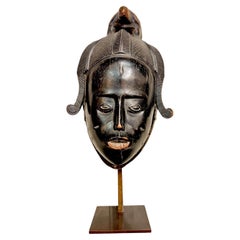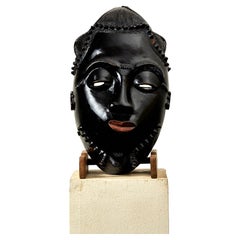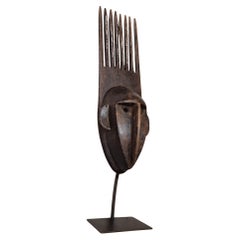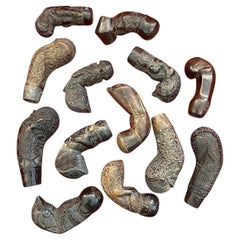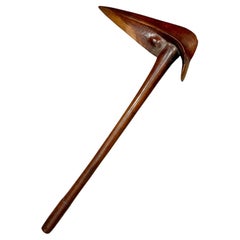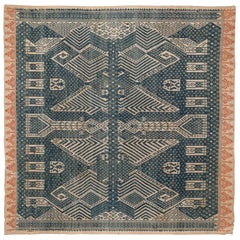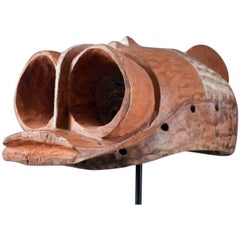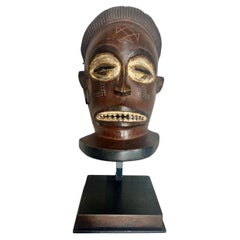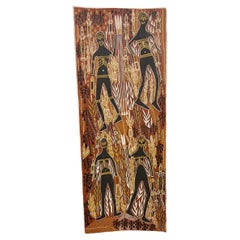Nice - Tribal Art
to
742
525
8
1
1
3
4
1
3
2
1
6
1
1
1
1
4
2
2
2
2
8
8
8
Item Ships From: Nice
Nigerian 19th Century Gold and bronze trade currency Bracelet
Located in NICE, FR
We present you an 19th century antique Nigerian high quality bronze GOLD PLATED bracelet currency traditionally used in monetary functions ...
Category
19th Century African Tribal Antique Nice - Tribal Art
Materials
Bronze, Gold Plate
Ndoma Baule Portrait Mask, Ivory Coast, Wood, lacquered patina, Circa 1930
Located in NICE, FR
"Ndoma” Baule Portrait Mask, Ivory Coast, Circa 1930 Wood, heavy wood with deep brown-black lacquered patina.
A superb old hardwood dance mask featuring an ...
Category
1930s Tribal Vintage Nice - Tribal Art
Materials
Wood
Baoulé portrait mask, carved wood, lacquer and pigments, circa 1940, Africa.
Located in Nice, Cote d' Azur
Baoulé portrait mask,
carved wood, lacquer and pigments,
circa 1940, Africa.
Height 29 cm, width 17 cm, depth 14 cm.
Category
1940s African Modern Vintage Nice - Tribal Art
Materials
Wood
Bamana N'tomo mask, Mali, 20th century
Located in NICE, FR
Bamana N'tomo mask, Mali, 20th century
"Generally surmounted by three to eight horns forming a comb, the N'tomoface mask refers to a moment of compulsory education given to uncircumcised young boys in certain West African societies. The mask's discreet, even absent, mouth emphasizes the behavior expected of them in their future adult life after training: controlling and measuring their words, knowing how to keep quiet, preserving secrets and enduring pain in silence."
Excerpt from Masques du N'tomo, Marc Ladreit de Lacharrière Collection, Musée du Quai Branly Jacques Chirac, France.
The Bambara, or Bamana, live in central and southern Mali. Their name means “unbeliever” and was given to them by the Muslims. Animists, they believe in the existence of a creator god called Ngala, who maintains the order of the universe and coexists with another androgynous god called Faro, master of the Word, who gave all qualities to mankind and makes the fruits of the earth grow. Traditional Bamana art objects are closely linked to agrarian rites.
The Bamana dance these masks during initiation and circumcision ceremonies for young boys in the Ntomo society. The face, with its vertical outgrowths at the top, adopts geometric features beneath a rounded forehead, including an imposing busted nose, as the Bamana favor this organ in their statuary as it evokes sociability and clan cohesion. Indeed, during choreography, the dancer frequently touches the nose of the mask.
As teaching aids for candidates, masks from societies accessible to young boys and adults, such as the N'tomo, Korè and Ci wara...
Category
1930s Malian Tribal Vintage Nice - Tribal Art
Materials
Wood
Collection of Kriss Handles, Java, Indonesia, Late 18th / Early 19th Century
Located in NICE, FR
A set of thirteen kriss handles originating from Java, Indonesia, dating from the late 18th to early 19th century.
Beautiful aged patina in dark or amber tones. Exquisite carving wo...
Category
1790s Indonesian Tribal Antique Nice - Tribal Art
Materials
Wood
Rare Kanak "kagu" Wooden Bird Beak Puzzle, New Caledonia, 19th Century
Located in NICE, FR
Rare Kanak war club of the "Kagu" type (Bird's beak) in hardwood, from New Caledonia, Melanesia, 19th century.
This is an exceptional Kanak art collector's item due to its imposing ...
Category
Mid-19th Century New Caledonian Antique Nice - Tribal Art
Materials
Wood
Ciwara Bambara headdress in carved wood and basketry, Mali, Early 20th century
Located in NICE, FR
A very pleasing Ciwara crest, singularly small and accompanied by its original headdress, depicting a stylized antelope leaning on a pangolin. The antelope is ridden by a woman, and white horsehair has been added to the tips of the horns. The piece is carefully sculpted, with notches decorating the bodies of the antelope and the pangolin.
Rattan, plant fiber, cowries, wood Very fine velvety mat patina, Circa 1950
An animal called Ciwara is said to have taught the Bambara how to cultivate the land, and during agrarian ceremonies, they recall the myth through the stylized representation of an antelope whose name ci wara...
Category
Early 20th Century Malian Tribal Nice - Tribal Art
Materials
Wood
Shell Plaque (Barava) from Solomon Islands, 19th Century
Located in NICE, FR
Objects crafted from the shell of the giant Tridacna clam, also known as the fossilized giant clam, held great value among numerous Melanesian peoples. The artistry of working with f...
Category
19th Century Solomon Islands Tribal Antique Nice - Tribal Art
Materials
Shell
Related Items
Early 20th Century Ceremonial Cloth / Tampan, South Sumatra, Indonesia
Located in Point Richmond, CA
Early 20th century Ceremonial Cloth / Tampan, Paminggir, Lampung region, South Sumatra, Indonesia
Commonly referred to as ship cloths, these ceremonial tampan would have been used as gifts, wrappers, cushions or pillows in any number of life-transition ceremonies, including children’s first hair cutting...
Category
Early 20th Century Indonesian Tribal Nice - Tribal Art
Materials
Cotton
$2,200
H 27 in W 27.5 in D 1.5 in
Nocturnal Bird Mask, Nigeria, Africa, circa 1950
Located in San Pedro Garza Garcia, Nuevo Leon
Very beautiful mask with large pronounced eyes with the circular cavity shape. The mask depicts a nocturnal bird that can see in the darkness and manifest the presence of divinities ...
Category
Mid-20th Century Nigerian Tribal Nice - Tribal Art
Materials
Wood
extremely rare Algerian Judaica silver, jewish Dowry box early 19th century
Located in Tel Aviv - Jaffa, IL
Amazing and scarce JUDAICA object, we have here one of the most touching jewish objects we had for a long time, this small silver dowry box was made in Algeria in the early 19th century, it is all covered with symbols of jewish faith and of couples, the sliding lid has 2 flanking birds with hamsa (protective hand) on each side and a flower vase in the middle.
one side shows two flanking lions with a tree in the middle and the other side shows again two big and two small birds with a flower bowl in the middle, front side has a key hole and next to it there is the Hebrew inscription ס״ט״" which says Siman tov or in English "a good sign" it is taken from the wedding blessing, underneath the lock there is another inscription with the name ״עזיזה בת אברהם בן חמו״ which is the name of the bride, her father and her grandfathers name.
the box is full marked a lot of times with the silversmith mark, every side of the box is marked.
this box was probably ordered by the grooms family to hold the jewelry they are giving to the bride as dowry, this type of objects are rare and there are just a few of them on museum collections.
DOWRY (Heb. נְדֻנְיָה), the property a wife brings to her husband at marriage; the Yiddish equivalent, nadn, is from the same root. The custom of nedunyah became clearly defined and institutionalized only in the talmudic period. In biblical times, mohar (מֹהַר), whereby the groom bought his wife from her father (Gen. 24:53; Ex. 22:15–16; Hos. 3:2), was the accepted practice. It was then customary that the groom give the bride gifts, and that she bring certain property to her husband's home upon marriage: slaves, cattle, real estate, etc. (cf. Gen. 24:59–61; 29; Judg. 1:14ff.; I Kings 9:16). Evidence of the custom of nedunyah is to be found in Tobit (7:14; 8:21) and in the Assuan papyri (Cowley, Aramaic, nos. 15, 18). Gradually, mohar was superseded by the ketubbah custom according to which the husband merely assumed the responsibility of compensation to his wife in case he divorced her: he had to pay her 200 zuzim if she had been a virgin at the time of marriage, and 100 zuzim if a widow or divorcée (see *Ketubbah).
By talmudic times, the institution of nedunyah was prevalent; the father gave a dowry to the bride since the daughter was excluded from paternal inheritance. Fifty zuzim (equivalent to the worth of 180 grams of silver) was the minimum amount a father was obliged to give to his daughter (Ket. 6:5). Parents usually gave much more, according to their social standing. Community funds provided the dowry for an orphan or a very poor girl (ibid.; cf. Sh. Ar., YD 251:8). In case of her father's death, the brothers of a minor girl were obliged to give her the minimum dowry, and the court estimated how much her father would have given her above the minimum dowry. The sum was then taken out of the father's estate and given to the daughter upon majority (Ket. 6:6; 68a–69b). In the absence of such an estimate, each daughter was entitled to receive one-tenth of the value of her father's estate in money, or in valuables (Yad, Ishut, 20:4–7; Sh. Ar., EH 113:4). If the father was unable or unwilling to pay the promised dowry at the betrothal ceremony, the groom could refuse to marry his bride (Ket. 13:5; Ket. 108b–109a). Insistence on exact payment of the promised dowry, however, was frowned upon by later rabbinic authorities (Rema to Sh. Ar., EH 2:1). In certain communities it was customary for the groom's father to make a dowry contribution equal to that of the bride's father (Ket. 102b). The dowry, whether given in real estate, slaves, money, or chattel was recorded in the marriage contract (the ketubbah) and in some instances one-third or one-fifth of the actual value of the dowry was added to the sum mentioned in the ketubbah. Based upon a decree enacted by *Simeon b. Shetah (first century C.E.), the Talmud ruled that the husband and his entire property were liable for compensation as stipulated in the ketubbah, either in case he died (when she collected the sum specified in the ketubbah from the heirs) or in case he divorced his wife (Ket. 82b). For the status of the dowry and the husband's rights and obligations, see below. The rabbinic enactments (Takkanot Shum) by R. Jacob *Tam and by the rabbinic synod of the communities of Speyer, Worms, and Mainz (Germany) stipulated that if a woman died...
Category
Mid-19th Century Algerian Antique Nice - Tribal Art
Materials
Silver
$15,000
H 2.8 in W 2.8 in D 5.6 in
19th Century Ethiopian Royal Bed (Former Tekalegn Besapa Collection)
Located in London, GB
This amazing nineteenth-century Ethiopian bed, personally collected in Ethiopia in the 1990's, formally belonged to the collection of Tekalegn Besapa, in Addis Ababa. This type of be...
Category
19th Century Ethiopian Tribal Antique Nice - Tribal Art
Materials
Wood
Mid-20th Century Toguna Female Anthropomo Post from Mali
Located in Atlanta, GA
An early to mid-20th century Toguna support post from the Dogon Tribe of Mali, on custom metal stand. This West African hand carved wooden bean was origin...
Category
Mid-20th Century Malian Nice - Tribal Art
Materials
Iron
Geometric Barmbara Sukuru Animal Mask with horns, teeth, Mali, West Africa
Located in Point Richmond, CA
Geometric Barmbara Sukuru Animal Mask with horns, teeth, from Mali, West Africa. Inserted wood teeth, abstract face with open eyes, with raised eyebrows and framed face. Old native...
Category
Mid-20th Century Malian Tribal Nice - Tribal Art
Materials
Wood
$3,600 Sale Price
20% Off
H 13.75 in W 7 in D 5.5 in
Slender 19th Century High-Backed Ethiopian Chair
Located in London, GB
This late nineteenth-century chair, from the Gindabarat in the Oromia region of Ethiopia, has been finely carved from a single piece of dense, heavy wood. The circular, narrow-in-siz...
Category
Late 19th Century Ethiopian Tribal Antique Nice - Tribal Art
Materials
Wood
Indonesian 'Wayang Golek" Shadow Puppet, Java, Indonesia, Early 20th Century
Located in Jimbaran, Bali
This “Wayang Golek” is a visibly old shadow puppet carved using soft wood and cloth. It features an articulated head and arms connected to rods, the dress...
Category
Early 20th Century Indonesian Tribal Nice - Tribal Art
Materials
Wood, Fabric
$516 Sale Price
20% Off
H 23.63 in W 4.73 in D 4.73 in
Mid-20th Century Tami Islands Papua New Guinea Tribal Wooden Feast Bowl
Located in Point Richmond, CA
mid-20th century Tami Islands Papua new guinea wooden feast bowl
Of classic form, each end carved with raised and incised imagery depicting stylized sea cr...
Category
Mid-20th Century Papua New Guinean Nice - Tribal Art
Materials
Kaolin, Wood
$4,200
H 4 in W 22 in D 9.5 in
Mud Cloth 'Bogolanfini', Mali, Bamana People, Mid-20th Century
Located in Ottawa, Ontario
A mud cloth (Bogolanfini),
Mali, Bamana People
mid-20th century.
Hand woven 'discharge dyed' cotton
Approximately 71 x 52 in. (180cm. x 132cm.)
A dazzling geometric pattern...
Category
Mid-20th Century Malian Tribal Nice - Tribal Art
Materials
Fabric
Weathered Archaic Bambara Wood Mask Fragment, Mali, Africa, Early 20th C.
Located in Point Richmond, CA
Add a piece of African history to your home. This is large and evocative of ancient times and ceremonies. Weathered wood mask fragment, Bambara people, Mali, Africa, late 19th-early ...
Category
Early 20th Century Malian Tribal Nice - Tribal Art
Materials
Wood
$1,795
H 14.75 in W 7 in D 5.5 in
Striking Makonde Animal Helmet Mask, Dog or Hyena, Tanzania, Early 20th C.
Located in Point Richmond, CA
Striking Makonde animal helmet mask, dog or hyena, Tanzania. Early 20th century with dark patina from traditional tribal use, wear inside from being used. Finely carved features, wit...
Category
Early 20th Century Tanzanian Tribal Nice - Tribal Art
Materials
Wood
$1,400 Sale Price
20% Off
H 10.5 in W 8 in D 10.5 in
Previously Available Items
Tchokwé mask from Angola in wood and pigments - Circa 1900
Located in NICE, FR
Tchokwé mask from Angola once owned by the American Abstract Expressionist artist Merton D. Simpson (1928 - 2013) renowned both for his work and as a dealer and collector of early Af...
Category
Early 20th Century Angolan Tribal Nice - Tribal Art
Materials
Kaolin, Wood
Aboriginal Bark Painting by Betty Guymatala, Australia
Located in NICE, FR
This aboriginal painting crafted on a piece of bark uses predominantly earthly colours, which are said to be the most often featured colour schemes in traditional aboriginal painting...
Category
20th Century Australian Tribal Nice - Tribal Art
Materials
Wood
Aboriginal Bark Painting by Emmanuel Wurrkidj, Australia
Located in NICE, FR
This impressive large aboriginal painting was crafted on eucalyptus bark from the Arnhem Land region in the Northern Territory of Australia. It was made by Emmanuel Wurrkidj who is a...
Category
20th Century Australian Tribal Nice - Tribal Art
Materials
Wood
Recently Viewed
View AllMore Ways To Browse
African Spear Currency
Ancestor Figure Papua New Guinea
Antique Ethiopian Crosses
Brazil Feather Headdress
Brazil Headdress
Copper African Masks
Dogon Mask
Tribal Crocodile Wood
Wedding Headdress
African Tribal Carved Wood Drum
Amazon Headdress
Asmat Tribal
Dogon Figure
Fiji Club
Fijian War Club
Gelede Mask
Kuba Beaded
Mali Doors
